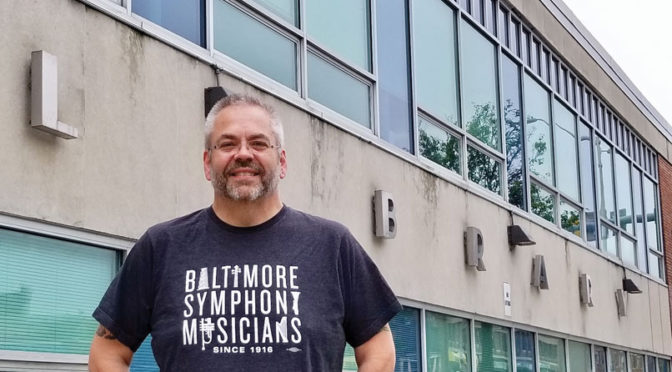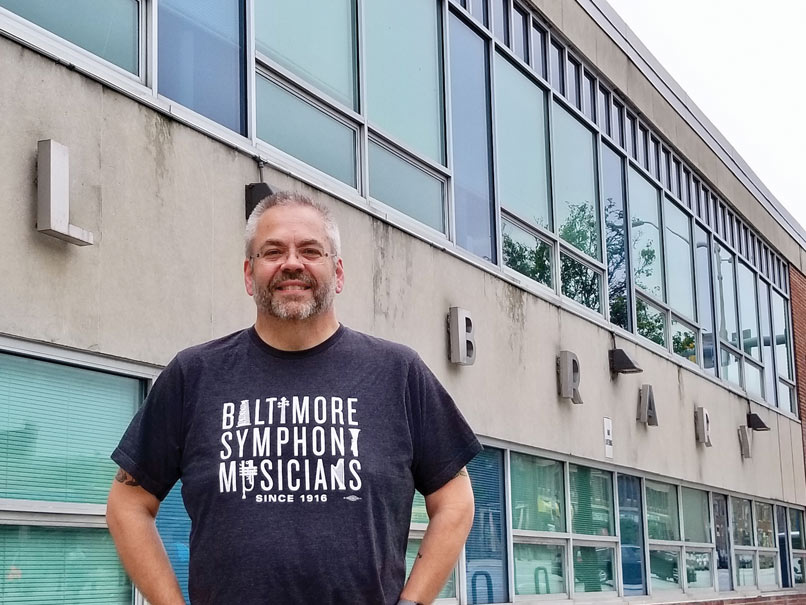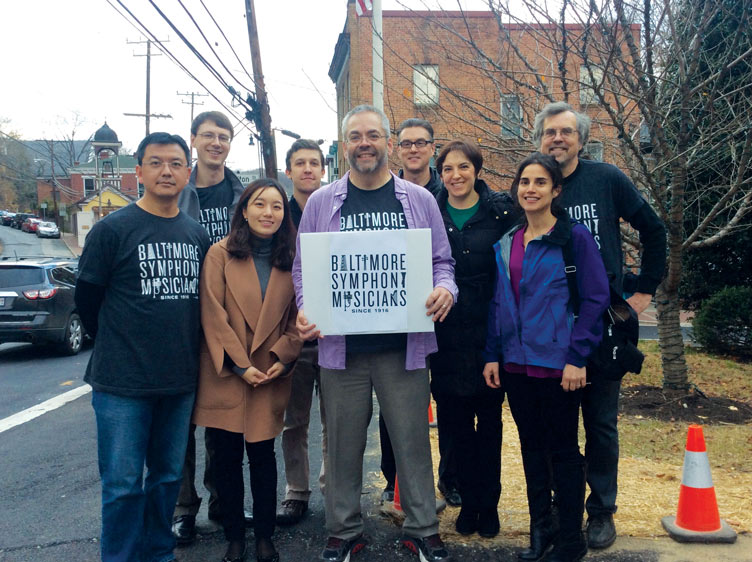Oboist Michael Lisicky of Local 40-543 (Baltimore, MD) was schooled in collective action during his first full-time orchestra position with the Savannah Symphony. “It was the most supportive and organized group of musicians,” he says. “To be part of a union body in a very nonunion town was a great bonding experience. That’s how I came to understand the power of a union and how to work collectively.”
“We were making just below the poverty line but we had full concert halls and lots of support,” he recalls. “In 1990, we had to prepare for an inevitable work stoppage.”
That’s when Michael Lisicky came up with the idea of creating an orchestra cookbook to raise funds and community awareness. The committee collected recipes from orchestra members, tested them, and printed and marketed the cookbook in just four months. “We put $4,000 in our kitty,” he says.
“We were out for upwards of 13 weeks, and in the end, we were able to get a 30% wage increase, spread over the course of the next three years,” says Lisicky. “Though we were still at a very modest annual salary, it was a big deal. In a small, sleepy, Southern city, union activity was not part of everyday life. We were so organized with concerts and working collectively that, in the long run, we got a settlement that we could be proud of.”
“At Savannah, I learned to be a good colleague; what affected one person, affected everybody; I learned how to stick together,” he says. “I don’t know if I would have been a leader or activist for 30 years without that early, firsthand training.”
Though Savannah was the first time he was part of a union action, his mom had instilled in him a deep respect for labor. “In the Philadelphia area most grocery stores were unionized and my mother would never cross a picket line. That’s when I first learned about solidarity and loyalty,” he says.
Growing up in Cherry Hill, New Jersey, Lisicky says he was lucky to have attended a public school with a strong music program. “It was the kind of program that insisted on excellence, whether you were thinking of going into music or not,” he says.
He graduated from the New England Conservatory before landing a job in Savannah, where he stayed just two years. In 1990, the strike forced him to look for other work. He won an audition for the Richmond Symphony.
While in Richmond, Lisicky attended his first Regional Orchestra Players Association (ROPA) meeting and was immediately enthralled. “I loved hearing the different stories from all the orchestras; I found it fascinating, so I became a delegate, member at-large, conference host, and finally treasurer,” he explains. “For the next six years the ROPA organization became my family.”
Orchestra in Crisis
Then, when the president of Local 123 (Richmond, VA) had to step down, Lisicky stepped up. “It’s an important role in a ‘right to work’ state where it’s hard to convince people that they should belong to the local,” he says.
Michael Lisicky recalls a particularly trying time at the local when an anonymous donor who wanted to “breathe new life into the orchestra” offered musicians with a certain number of years of seniority up to three years’ pay to retire. “You can’t retire on three-years’ salary at age 50, but when you are approached with this offer you wonder, ‘If I don’t do this, what is my future?’” explains Lisicky. “We saw this as age discrimination.”
“The buyout was probably my most difficult experience as a leader on an orchestra committee; it was debilitating,” he says. “One third of the orchestra took the buyout. It was a painful decision and there was a lack of transparency. We tried to get the best package we could working with the AFM.”
In 2004, Lisicky joined Baltimore Symphony Orchestra. “I had a great experience learning the industry in Savannah and Richmond, but I love being in a non right to work state and I love being in a full 52-week orchestra playing big, full programs all year long,” he says.
“When I left Richmond it was a breath of fresh air and I felt that I had retired from union and orchestra committee activity. But people get tired, leave, and it’s time for new blood to step up,” he says. “I became an unemployment guru when we had to go through some furloughs, then I got involved in the players committee.”
“There came a time, a few years ago, where we had to say what Baltimore Symphony’s role in the community was, but we had no clear role. We had done things individually, but collectively we didn’t have a face or a brand,” he says. “I didn’t want to be in the position where I had to defend an orchestra in our community.”
This all came up in April 2015, in the turbulent days following the death of Freddie Gray. “The city kind of shut down and we went through a hard night. Some people had been living with the issues that instigated the unrest, and many of us were just learning about what had been going on for decades,” he says.
“I came up with the idea of getting some colleagues together to sit outside the hall the next day and play some music. The committee supported me and the person in charge of marketing grabbed onto the idea. Lo and behold, I contacted every musician in the orchestra and we gave a nice chamber music performance,” he says. “We had every media outlet in the world coming to watch Baltimore collapse and we put on a performance.”
“It wasn’t a concert; it was about getting the community together and taking a break—a very moving experience. We had all the colors of the rainbow there—a thousand people or so outside the Meyerhoff Symphony Hall on a beautiful day at the end of April,” he says. “When it was over, we were still in crisis.”
Meyerhoff was one mile from the heart of the unrest, and some people felt that we should be at the epicenter. “So, the next week we sent a woodwind quintet out to the epicenter just to kind of show we were not afraid to go there,” he says. Noticing the library close by, Lisicky contacted them about doing a concert series the following spring. “Anyone can perform and leave; it doesn’t show any commitment. We want to make a real connection with the community.”
The Work of a Musician
The Baltimore Symphony Musicians’ community outreach, and Lisicky’s commitment to it, grew from there. “I think coming together is a good exercise in collective action. Our goal is to bring Baltimore Symphony Musicians into the best light possible—to have the community know who we are and realize we have a purpose.”
Michael Lisicky is also known for stepping into leadership roles in organizing and pressing others into service. “The standard response is ‘I wouldn’t be good at this,’” he says. “If you don’t want to get involved with the players committee, where the grunt work is, get involved with a subcommittee.”
“I would also encourage people to read their contract and know a little bit about the history,” he says. “There is a reason why we have work rules and certain conditions that are not necessarily applicable from orchestra to orchestra. There are reasons why certain things were put into a contract, not just to protect you, but also the organization. Longtime musicians should educate those who are coming on board.”
“I didn’t realize when I went to school to learn to play the oboe how much non-oboe work there was going to be,” he says. “You want to win that job, then you want to get tenure, then you want that job not just to survive, but to thrive. That takes extra work.”
History Buff
Aside from performing in the symphony and organizing community events, Lisicky is also a published author with a curious focus on the history of department stores. “Through a crazy obsession I became something of an expert,” he says. “My mother loved these places and I was always intrigued by the history; they have been around for generations and defined communities. I never wanted to be an author, but I liked putting together these projects so we could remember the roles these stores played in these cities. It’s kind of how orchestras are part of their communities.”
He has also researched his orchestra and wrote the book, Baltimore Symphony Orchestra: A Century of Sound (2015). “It’s hard writing about your job,” he says. “No one knew in 1916 what it was going to be like in 100 years; when I looked at 2016 I tried to remain optimistic in a challenging environment.”
“For its first 25 years, the Baltimore Symphony was the nation’s only fully-funded public symphony orchestra,” he says. “We were unable to grow because we had only so much funding. We had a revolving door of conductors who thought publicly funded orchestras were the way to go, then when they wanted to increase the quality and they didn’t have the money, they would leave.”
“Back in the 1930s, when they were challenging the line item, the mayor stood up and said that symphony orchestras are just as important to the quality of life as street lights and public toilets,” says Lisicky. “As a civically funded organization, we were cheaper to attend than the Philadelphia orchestra, so we were kind of a working class orchestra. By the 1940s, we became the face of Baltimore, traveling throughout the country and to Carnegie Hall.”
“It wasn’t until 1970, when we had a commitment to quality from Conductor Sergiu Comissiona and Joseph Meyerhoff, head of the board, who decided to invest in the orchestra and grow us from a sleepy little orchestra to one of the nation’s top orchestras,” he recounts. “The organization had two big work stoppages in the 1980s where they wouldn’t have received positive outcomes except for the collective work at the time.”
This summer, Lisicky looks forward to BSO’s August tour to Ireland and the United Kingdom, which includes a stop at the Proms festival. And Lisicky is always looking for the next outreach project. “Sometimes it’s a long-range thing—creatively coming up with an idea or it’s a ‘triage performance’ following an emergency.”
“As long as musicians, boards, management, and communities remain advocates for one another, we’ll have a chance,” he says. “Getting the next board together and looking ahead three, five, 10 years, that’s the challenge.”
In Baltimore, the focus on community engagement that began in 2015 has done much to raise the profile of the orchestra. Lisicky’s advice to other orchestras wanting to up their community outreach game: keep it simple.
“We have a tendency to overthink and that cripples you. Do it for the right reasons, not to just get it down on paper. Challenge yourself; when we take a step outside our comfort zone we can all accomplish things.” He adds, “Have a brand; make yourselves identifiable through social media. As you become identifiable, you develop more contacts in the media who will cover the orchestra in the future.”




